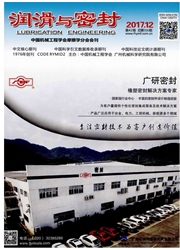

 中文摘要:
中文摘要:
目的从磨削液压力及润滑方面找到减少磨粒磨损、磨削热和降低工件表面粗糙度的方法。方法基于实际情况,将砂轮突出的磨粒分布函数和工件在磨削之前存在的粗糙度函数等效为余弦函数,对陶瓷结合剂CBN砂轮磨削45号钢而产生的流体压力和膜厚进行了分析。结果考虑砂轮和工件的表面粗糙度时,压力波动集中在中心区域,磨削区最大压力和最大膜厚明显增大。在考虑热效应的情况下,当两表面波长相等、幅值同时增大时,最大膜厚及平均膜厚增大,而幅值相等、波长增大时,润滑情况没有改善;当砂轮表面幅值波长相等且变大时,最大膜厚及平均膜厚增大,由此也可以得出当砂轮表面幅值波长不变,工件表面如此变化时结果相同;当两表面幅值和波长不相等且都成倍增大时,最大膜厚及平均膜厚增大。结论膜厚增大利于润滑时,能降低磨削温度,减少磨削烧伤和热变形,降低工件磨削后的表面粗糙度,减少非工作磨粒的磨损,减少砂轮修正次数,延长砂轮寿命。但是膜厚不会无限增大,因为磨削区域并不封闭,在实际工程中可依据此理论来确定最优解,优化磨削过程。
 英文摘要:
英文摘要:
The work aims to study find ways to reduce abrasive wear, grinding heat and lower the surface roughness of the workpiece from grinding fluid pressure and lubrication. This article based on the actual situation,The abrasive particle distribu- tion function and the roughness function of the workpiece before grinding are equivalent to the cosine function, When the ce- ramic bonded CBN grinding wheel grinding No. 45 steel,the fluid pressure and film thickness are analyzed. The results show that considering the surface roughness of the grinding wheel and the workpiece, the pressure fluctuation is concentrated in the central area, the maximum pressure and the maximum thickness of the grinding area obviously increased. In the case of thermal effects: When the wavelength of two surfaces are equal and the amplitude of two surfaces increases simultaneously, the maxi- mum film thickness and average film thickness increases. When the amplitude of two surfaces are equal and the wavelength of two surfaces increases simultaneously, the lubrication does not improve. When he amplitude of the grinding wheel surface is equal to the wavelength and increase simultaneously, the maximum film thickness and average film thickness increases, which can also be obtained when the wheel surface amplitude and wavelength constant, the workpiece surface change the same situa- tion; when the two surface amplitude and wavelength are not equal and multiplied, the maximum film thickness and average film thickness increases to, the above three conditions, the increased film thickness which conducive to lubrication can lower the grinding temperature, reduce grinding burns ,thermal deformation and the workpiece roughness after grinding. It also can reduce the wear of non-working abrasive grains and the number of grinding wheel correction to extend the wheel life. But the film thickness will not increase indefinitely, because the grinding area is not closed, but the optimal solution can be based on this theory in the actual project to optimize the gri
 同期刊论文项目
同期刊论文项目
 同项目期刊论文
同项目期刊论文
 期刊信息
期刊信息
